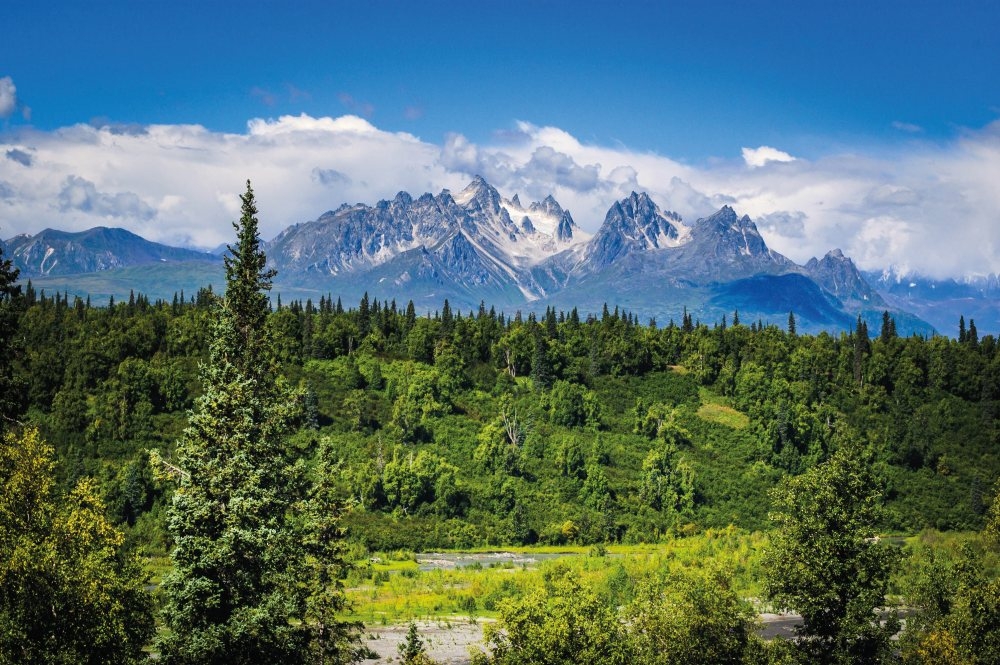- Details
- Written by: Sian Lewis
The last wilderness. The final frontier. The land of the midnight sun. Civilization only really skirts the edges of Alaska, America’s biggest and most untrodden state. One third the size of the entire continental US, Alaska is home to permafrost, deserts, rainforest and eight huge national parks, but just 700,000 people. Some of its glaciers alone are the size of entire states, and Russia is only a short hop away across the Bering Strait. This is the USA, but not as you know it.
I arrive at Anchorage airport at 10pm, but the sun is still high in the sky, spreading a golden light over Alaska’s largest city. I struggle to sleep in the seemingly endless midnight sunshine, but the next morning, plentiful coffee and cinnamon rolls served by waitresses who call me “hon” at Anchorage’s favourite café, Snow City, give me the caffeine and sugar injections I need.
Two float plane pilots sitting next to me at the breakfast bar immediately ask me where I’m planning to go hiking and even draw me a map on a napkin of where to explore, all while telling me tales of their adventures flying into remote Alaskan rivers, reachable only by plane, to fish for salmon. “Once I saw a jet-black wolf in the woods,” says one of them, and he fishes out his bear spray to show me which brand he recommends.
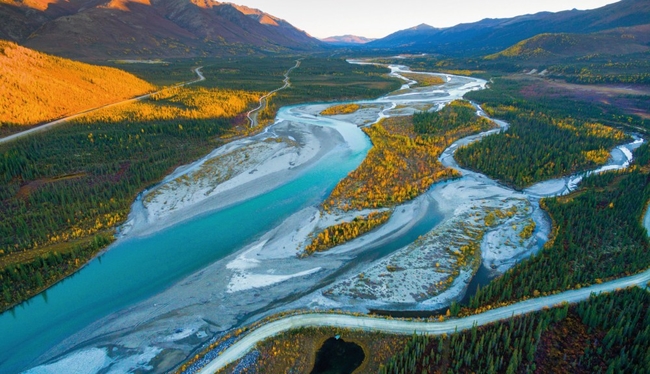
I’m here to join Grand American Adventures on a two-week hiking and camping journey across this wild state, and the next morning I meet my guide, Lana, and we head out of Anchorage, quickly swapping the city limits for miles of forest, punctuated by the occasional sleepy town where shops have names like Big Bubbas’s Trailers and Mugshot Saloon and the Mushing Mortuary.
As we drive, I read Susan Ewing’s nature guide to Alaska, learning to recognise the footprints of moose, wolf and grizzly bear. “Other states can guide you to their remaining wild areas, but Alaska doesn’t have nature – Alaska is nature.” Ewing adds as a postscript.
Call of the wild
We leave any semblance of a town behind and head towards the white-capped mountains, along a road lined by the bright pink fireweed flowers that are everywhere in Alaska in summer. In the distance, white-capped Mount Denali, the highest mountain in the United States at 6,190 metres, towers over its peers. We roll into Denali National Park – a jaw-dropping six million acres of mountains and tundra.
We finally get out of the car after a six hour drive. Distances in Alaska, I’ll come to learn, are deceptively huge, and roads are few – no wonder all the locals have their own tiny planes. I’m desperate to get out into the wild hills around us, and set straight out to follow the 10 mile Triple Lakes Trail on the edge of the park.
I hike the narrow, pine-flanked mountain trail with Chris, who has also done his homework on the flora and fauna we might encounter. “We should make constant noise to warn any bears” he says, worriedly. I’m sceptical, until we round a corner and find a so-fresh-it’s-still-steaming pile of bear poo in the middle of the trail.
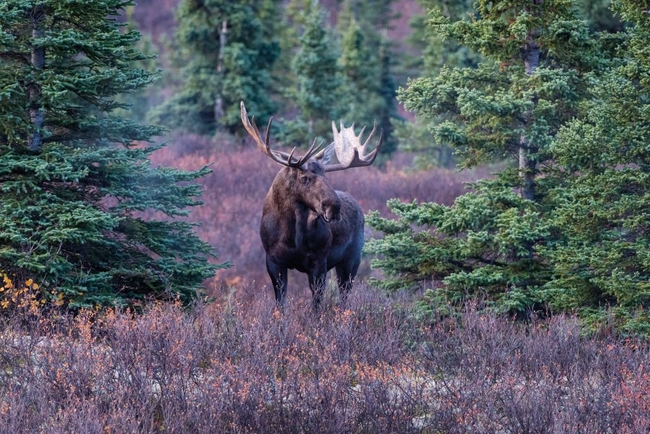
We hike on, more loudly this time, climbing up the steep sides of the hill in the sunshine, eyes peeled for elusive furry beasts. But it turns out not to be bears we need to worry about. High on the mountain ridge, we suddenly spot a massive moose and her comically long-legged baby standing in a blueberry patch. The mother makes harrumphing noises and starts striding towards us. We back off, sweating with fear, until they’ve moved away. When it feels safe to move, we carry on along the path as it winds back down to the valley, past three lakes, where beavers have built careful dams. We make it back to our first campsite without being eaten.
The next morning we rattle along dirt roads into the heart of Denali National Park. More Alaskan enormity – it takes four hours by car just to reach the main visitor centre from the park’s entrance. But it’s well worth it - from here you can get panoramic views of the mountains by hiking up steep paths into the range.
I stand, sweating with exertion, at the summit of Mount Thorofare after a three-mile climb and look down at the endless miles of tundra cut through by gleaming rivers and thick patches of forest. On the bumpy ride back to camp, we drive around a switchback and suddenly see an enormous mama grizzly and her cub striding along the plain. The baby is gambolling by his mother’s flank, the mother playfully batting him away with an enormous paw. They look totally at home, and utterly unphased by our presence.
We leave Alaska’s few tarmacked roads behind and bump over dirt on the Denali Highway, eventually rolling into the town of Chitina, population 126. ‘Where the hell is Chitina?’ reads a bumper sticker, and as we get out to eat our sandwiches a moose calmly crosses the road and goes for a swim in the local lake. From here we’re driving to McCarthy, another bone-rattling eight hours down a dirt road into the heart of the jewel in Alaska’s national park collection, Wrangell-St Elias. This astonishing wilderness preserve is bigger than Switzerland and home to four mountain ranges and thousands of glaciers. Like most of Alaska, we puny humans only scratch its surface.
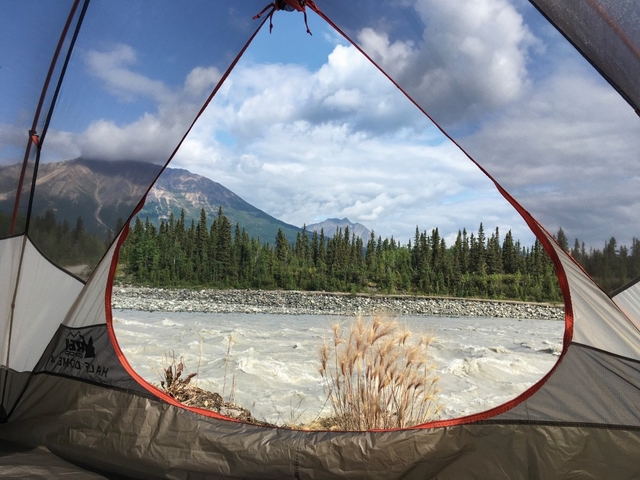
After eight hours more driving, we emerge, dusty and exhausted, at our campsite next to the tiny town of McCarthy, flanked on one side by the rushing Kuskulana River and on another by the huge hulking mass of Root Glacier. McCarthy, population 17, is the very definition of a one-horse town. But it’s a charmingly old-fashioned one, complete with a wooden saloon where honest-to-god cowboys prop up the bar.
Chris and I grab our boots for a five-mike hike along a sleepy woodland trail to get a closer look at the edge of the glacier, then hitchhike back to the campsite. The local who lets us ride in the back of his dusty pickup chats to us as if we were old friends. I fall asleep in my tent to the sound of the river rushing with glacial water, tall mountains framed by the canvas of the doorway.
- READ NEXT - Top 10 Best Lightweight Walking Boots
Ice ice baby
The sun is already high in the sky and our guide, Mike, is waiting for us at 6am the next morning. He’s laden with climbing ropes, crampons and ice axes. Today, we’re taking on the glacier. We hike across the huge sheet of ice, then walk deeper onto the glacier and into a maze of pathways, caves and moraines. Mike seems to know exactly where he’s going, despite the fact that the glacier is ever-changing, and leads us down into a small bowl where there is a vertical ice wall perfect for ice climbing newbies. At the top of the climb, he twists a pair of screws into the ice. “Don’t worry, they’ll hold you!” he grins.
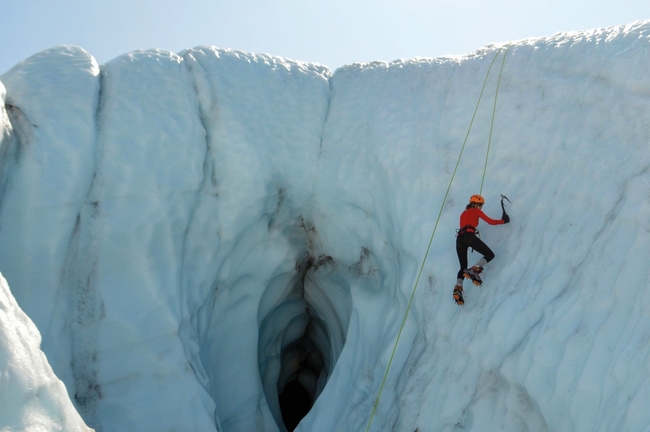
I’ve climbed on rock plenty of times, but it proves a pretty different sport when you’re smashing your axes and crampon edges into slick ice and praying they hold with every slow, hard-won move up the wall. I finally make it to the top of the climb, ecstatic. But we haven’t finished our ice initiation yet – Mike decides we’re ready to try climbing in a moulin, and lowers me into one of the deep, narrow fissures in the ice. I can’t see the bottom below me – the frozen blue walls just fade to black, and I hang from the rope above an abyss. When I drop a shard of ice, I can’t hear it hitting the bottom.
“There’s one more rite of passage for climbers” says Mike, leading us across the ice to an astonishing blue glacial lake, totally hidden unless you know where to look. The water is the colour of sapphire. “It’s a tradition. If you’ve been ice climbing, you have to take the plunge.” I clamber down to the water’s edge and before we can think it through too much, jump into the water. It’s so cold my body barely registers what’s happening, and I have to haul myself onto the ice like a seal to climb out. But far from freezing, I feel strangely warm and well, as my skin zings.
Coastal cruising
You could argue that you haven’t really seen Alaska until you’ve explored it from the water – after all, this is a country where salmon is king, with a coastline longer than that of all the other US states combined. In order to kayak in Alaska’s glacial waters we pull on baselayers, waterproofs and then huge orange oilskin dungarees and jackets - the same worn by the fishermen our boat speeds past as we head to reach Prince William Sound.
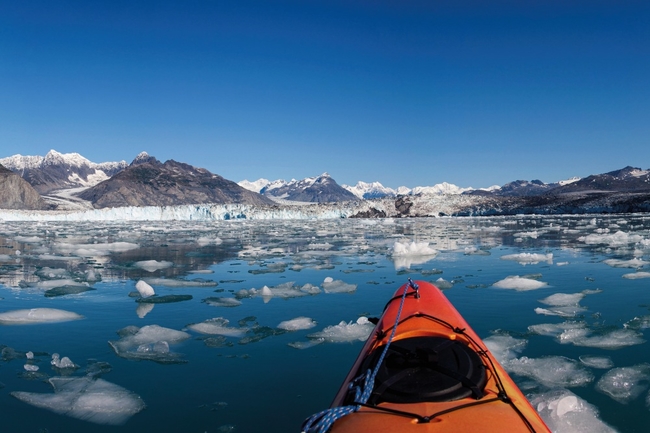
Blue and emerald-tinged icebergs tower above the surface, while smaller chunks of ice endearingly known as ‘bergie bits’ jostle against each other around their base. We clamber awkwardly into brightly coloured kayaks on the shore, then paddle among the ice, arms straining as we try to guide our kayaks around the countless floes that seem to threaten to close up around us.
You could spend the rest of your life hiking astonishing trails in Alaska and still only see a tiny of fraction of its beauty. For our final walk in the wild, my tent mate Rose and I pick a real beauty. We pack our bear spray for a stiff eight mile climb up to the top of the Harding Icefield in the Kenai National Park, and a park ranger checks that we know to use it before we set off. “Plenty of tourists end up accidentally gassing themselves,” she says, trying not to laugh. “We even had a family who thought you could use bear spray like mosquito spray, and they sprayed it liberally on their children.” Luckily, we encounter no curious creatures as we hike up, clambering onto the ice of the glacier where it has spilled over the trail.
Two weeks of hiking and semi-wild camping have taken their toll, but we finally get to take hot showers at our last campsite. To celebrate no longer smelling awful, Rose and I have a few beers at the Yukon Bar, where a local band are playing ska, and a stuffed polar bear head sits surrounded by guns mounted on the wall – it seems like a strange antithesis to the thriving natural world just beyond the town limits.
We have just one day left in the wild, so we explore as Alaskan locals do – by float plane. A tiny plane moored outside a wooden cabin on a lake, buzzes us out to the Kenai Peninsula and lands us in what is quite literally the middle of nowhere. We sit in the boat and wait and watch, listening to the sounds of the lake, as our guide catches a salmon and cuts it up for us, sushi style. Then, from nowhere, a grizzly bear emerges from the undergrowth, spots us and with supreme unconcern, wades in and dives for her own salmon, plunging her enormous paws into the water.
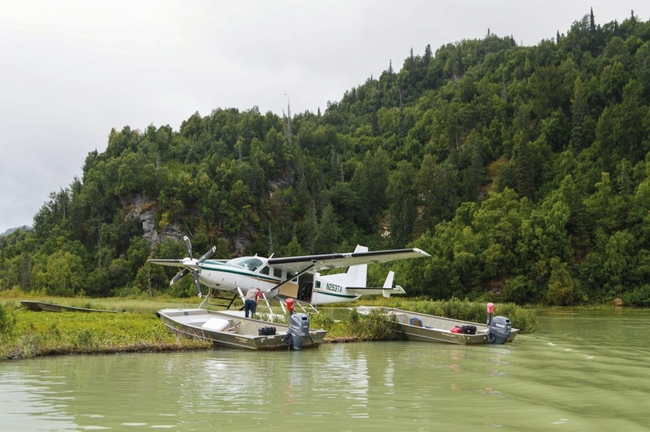
I could watch her for hours, but our ride home is waiting. We fly back over the tundra, looking down at the grizzly’s domain - endless miles of winding rivers and marshes with no signs of humankind anywhere. This may be the last wilderness, but it’s a truly magnificent one.
Five weird and wonderful towns in Alaska
Chicken
One of the few surviving examples of a gold rush town in Alaska, Chicken was named by hunters who shot the plentiful local ptarmigan – except no-one could spell ptarmigan, so they simply called the town Chicken instead. Only seven people live here now, but it boasts both a saloon and a liquor store.
McCarthy
Arriving in this tiny town feels like you’ve stepped into the Wild West, complete with frontier saloons, wood-fronted stores and real life cowboys propping up the bar.
Nikolaevsk
A slice of old Russia hidden in the Alaskan wilderness on the Kenai peninsula. Pop in for a drink at the Russian Samovar Café.
Whittier
“It’s always shittier in Whittier” goes the local saying, but this Cold War relic is well worth a visit. The town itself is composed of two enormous tower blocks - one of which is now deserted, with most of the town’s 200 residents living in the other. In winter they move between buildings through tunnels.
Yakutat
It might be one of the most isolated places on the planet, but that doesn’t stop surfers flocking to ride the big waves which hit Alaska’s southern coast. Don’t forget your thickest wetsuit.
Travel info
Our trip
Sian’s trip was supported by Grand American Adventures whose 14-day Alaska, Wildlife and Wilderness tour, starts from £2,919 per person, including accommodation, specialist guides, transportation, floatplane trip and most of your meals.
grandamericanadventures.com
Getting there
Fly to Anchorage from London via Denver with United Airlines from £865 return.
Health & safety
Beware of bears. Follow local advice, don’t hike alone and carry bear spray with you.
What to pack
Mosquito spray, good hiking boots and good waterproof gear are essentials.
Getting around
A car is the easiest way to cover Alaska’s big distances. Multiple car rental companies operate out of Anchorage and Juneau. Cruise America offer RV rental from Anchorage.

